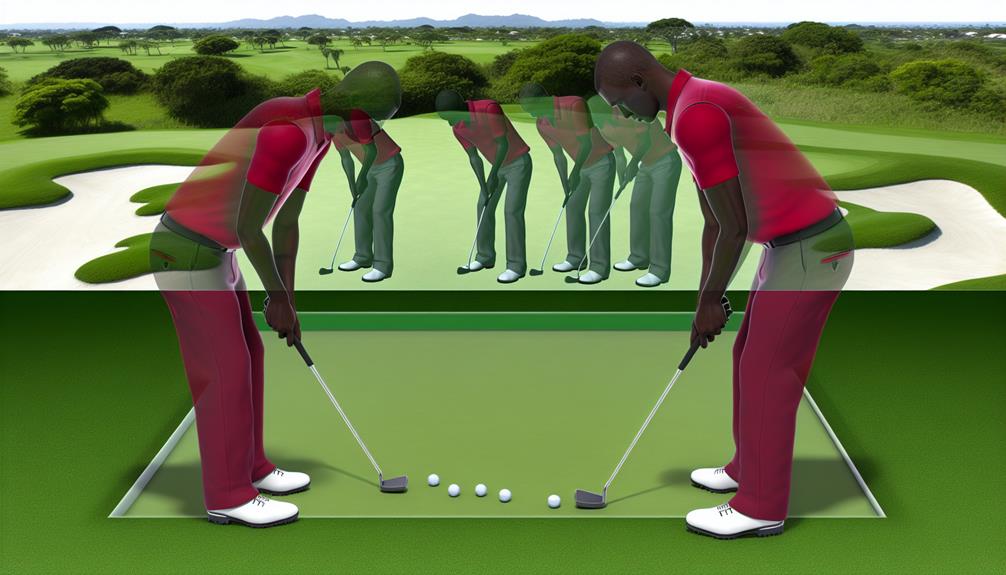It's no secret that perfecting your golf putting technique is akin to finding the Holy Grail of golfing. As you venture into the world of golf, you'll quickly realize that the key to lowering your scores and outperforming your competitors lies not just in big swing shots, but more importantly in the consistency of your putting.
But why is this so critical? You might ask. Well, imagine you've hit the perfect drive, navigated the fairway with precision, only to falter at the final hurdle because your putting isn't up to scratch. Frustrating, isn't it? Just wait until we unravel the gravity of this seemingly simple aspect of golf.
Understanding Consistency in Golf Putting
To truly master the art of golf putting, you need to understand the crucial role of consistency in your technique. It's not just about hitting the ball hard or aiming right; it's about repeating the same optimal movement every time. That's where psychological preparation comes into play. You've got to develop a routine that gets you in the right mindset, clearing your thoughts and focusing only on the putt ahead.
Understanding the putting surfaces is equally important. Grass type, grain direction, moisture level – these can all drastically affect the ball's path. You need to study each green, learn its quirks and nuances, and adjust your technique to match. That's consistency. You're not just hitting the ball; you're crafting a strategy based on a myriad of variables.
Mastering the Perfect Putting Grip
Grasping your putter correctly is the foundation for a successful putt, ensuring stability, control, and precision in your swing. A consistent grip is key, but you must also pay attention to grip pressure. Excessive pressure can lead to inaccuracy, while too little can cause the putter to feel unstable. Ideally, your grip should be firm yet relaxed, allowing for slight adjustments during the swing.
Putter selection also plays a significant role in mastering the perfect putting grip. The putter's size, weight, and design can affect how it fits in your hands and, consequently, how you grip it. When selecting a putter, it's essential to choose one that feels comfortable and natural in your hands. This way, you'll be able to maintain a consistent grip that doesn't strain your hands or compromise your swing.
Mastering the perfect putting grip is a matter of balance. It requires understanding and managing your grip pressure, choosing the right putter, and practicing consistently. Remember, a good putting grip gives you control over the putter head, helping you make precise, accurate strokes. So, invest time in perfecting your grip, and you'll see an improvement in your putting performance.
Importance of Ball Position and Alignment
In the game of golf, understanding the significance of ball position and alignment is as crucial as mastering your grip; it's a fundamental aspect that can greatly influence the accuracy and distance of your putts. This isn't just about where the ball is but also how you align your body and club with the hole.
Posture importance can't be overstated. A proper stance will enable you to strike the ball at the right angle, influencing the trajectory and eventual landing spot. Align yourself parallel to the target line, with your feet, hips, and shoulders all pointing in the right direction. This alignment will provide a clear, unimpeded path for your swing.
The ball's position relative to your stance is another crucial factor. Ideally, it should be in the center of your stance for a standard putt. However, this may vary depending on the slope and length of the green.
Club selection also plays a pivotal role. A putter that matches your style and physique can improve your alignment and, by extension, your overall performance.
Implementing Effective Putting Drills
Understanding and implementing effective putting drills can significantly elevate your golf game, giving you the edge you need on the green. The key here is drill selection. Not all drills are created equal, and your choice should align with your specific needs and areas for improvement.
For instance, if you're struggling with controlling distance, the 'ladder drill' where you putt balls to incrementally further distances, can be beneficial. On the other hand, if accuracy is your issue, the 'gate drill,' which requires you to putt through a narrow gap, could be your go-to.
Once you've selected your drills, it's crucial to practice consistently. This doesn't mean mindless repetition, but focused, deliberate practice with attention to detail.
Performance tracking is your best friend here. Keep a record of your progress, noting improvements and areas still needing work. This data-driven approach will provide insights into your strengths and weaknesses, allowing you to adjust your drills accordingly.
Evaluating and Adjusting Your Putting Technique
As you refine your golf game, it's crucial that you continually evaluate and adjust your putting technique, ensuring your strokes are both efficient and effective. Analyzing putt speed is a key part of this process. The speed of your putt can drastically influence the ball's direction and distance. Too slow, and you'll fall short of the hole; too fast, and you'll overshoot.
Take time to observe how your ball rolls after each putt. Is it consistently too fast or too slow? Adjust your swing strength accordingly. Practice different speeds on various terrains to gain a well-rounded understanding of how speed impacts your shots.
Your club selection strategy also plays a vital role. Different clubs are suited for different distances and terrains. For instance, a putter with a heavier head can provide more control and consistency, especially on faster greens. Experiment with different clubs and observe how they affect your putting.

